| Srl | Item |
| 1 |
ID:
035312
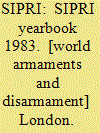

|
|
|
|
|
| Publication |
London, Taylor and Francis Ltd., 1983.
|
| Description |
lvi, 681p.hbk
|
| Series |
SIPRI Yearbook 1983
|
| Standard Number |
0850662478
|
|
|
|
|
|
|
|
|
|
|
|
Copies: C:1/I:0,R:0,Q:0
Circulation
| Accession# | Call# | Current Location | Status | Policy | Location |
| 021686 | 327.17405/SIP 021686 | Main | On Shelf | General | |
|
|
|
|
| 2 |
ID:
063165
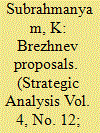

|
|
|
| 3 |
ID:
152189


|
|
|
| 4 |
ID:
137971
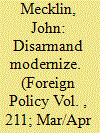

|
|
|
|
|
| Summary/Abstract |
In the early decades of the Cold War, NATO made arrangements to bury what were known as atomic demolition munitions (in essence, nuclear mines) at key points in West Germany, to be detonated if Warsaw Pact forces ever invaded. Although this plan, if enacted, might have slowed the enemy advance, it also almost certainly would have turned vast West German territories into radioactive wastelands littered with corpses and smoldering buildings—the stuff of hellish alternative-
history scenarios. The West viewed such tactical nukes—NATO fielded 7,000 to 8,000 of these shorter-
range, smaller-yield weapons for most of the Cold War—as tripwires in anticipation of the Soviet Union’s own Strangelovian plans for its thousands of tactical weapons. That is to say, the forward positioning of these nukes was a signal: If the Soviet Union invaded Europe, confrontation would escalate quickly to the nuclear realm, and the United States would intervene.
|
|
|
|
|
|
|
|
|
|
|
|
|
|
|
|
| 5 |
ID:
056135
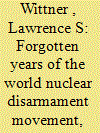

|
|
|
| 6 |
ID:
154202
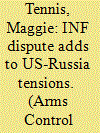

|
|
|
| 7 |
ID:
077477
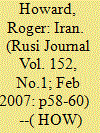

|
|
|
| 8 |
ID:
155588
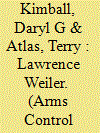

|
|
|
|
|
| Summary/Abstract |
Lawrence Weiler was special assistant to the director of the U.S. Arms Control and Disarmament Agency (ACDA) and a U.S. negotiator on the nuclear Nonproliferation Treaty (NPT) and other arms control measures during his government service under six U.S. presidents. As that landmark accord approaches its 50th anniversary next year, Weiler, now 96, recalled its creation and assessed its impact in a June interview with Arms Control Association Executive Director Daryl Kimball and ACT Editor Terry Atlas.
|
|
|
|
|
|
|
|
|
|
|
|
|
|
|
|
| 9 |
ID:
100131
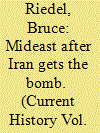

|
|
|
| 10 |
ID:
184886
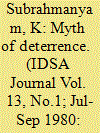

|
|
|
| 11 |
ID:
171532
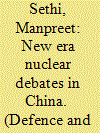

|
|
|
| 12 |
ID:
184923
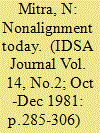

|
|
|
| 13 |
ID:
164635
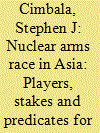

|
|
|
|
|
| Summary/Abstract |
North Korea’s unpredictable behavior with respect to its nuclear arsenal is only one element of a nuclear arms competition among powers in Asia. Nuclear Asia is a potential cockpit for an outbreak of accidental nuclear war or deliberate nuclear first use, as among regional rivals and adversaries. In addition, a limited nuclear war between regional enemies could ignite intervention by outside powers and intensify, in terms of its potential for horizontal or vertical escalation. Research does not support a definitive relationship between the numbers of nuclear weapons states acting in Asia or in the Pacific and the probability of war, including nuclear war. On the other hand, the availability of nuclear weapons may make more states risk acceptant instead of risk averse in regional conflicts, and overconfident with respect to their skills in managing escalation. That finding is important because states’ abilities to manage escalation may be more important than the sizes of their arsenals.
|
|
|
|
|
|
|
|
|
|
|
|
|
|
|
|
| 14 |
ID:
159005
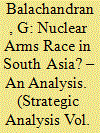

|
|
|
| 15 |
ID:
060857
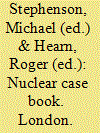

|
|
|
|
|
| Publication |
London, Frederick Muller Limited, 1983.
|
| Description |
144p.
|
| Standard Number |
0584110790
|
|
|
|
|
|
|
|
|
|
|
|
Copies: C:1/I:0,R:0,Q:0
Circulation
| Accession# | Call# | Current Location | Status | Policy | Location |
| 027545 | 355.0217/STE 027545 | Main | On Shelf | General | |
|
|
|
|
| 16 |
ID:
140230
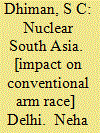

|
|
|
|
|
| Publication |
DelhI, Neha Publishers and Distributors, 2015.
|
| Description |
v, 296p.hbk
|
| Standard Number |
9789380318769
|
|
|
|
|
|
|
|
|
|
|
|
Copies: C:1/I:0,R:0,Q:0
Circulation
| Accession# | Call# | Current Location | Status | Policy | Location |
| 058291 | 327.1740954/DHI 058291 | Main | On Shelf | General | |
|
|
|
|
| 17 |
ID:
131079
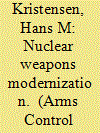

|
|
|
| 18 |
ID:
128327
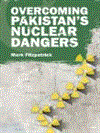

|
|
|
|
|
| Publication |
Oxon, IISS Routledge, 2014.
|
| Description |
171p.Pbk
|
| Series |
Adelphi Series No.443
|
| Standard Number |
9781138796676
|
|
|
|
|
|
|
|
|
|
|
|
Copies: C:1/I:0,R:0,Q:0
Circulation
| Accession# | Call# | Current Location | Status | Policy | Location |
| 057680 | 355.825119095491/FIT 057680 | Main | On Shelf | General | |
|
|
|
|
| 19 |
ID:
107586
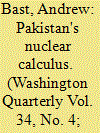

|
|
|
| 20 |
ID:
147848
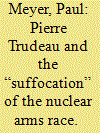

|
|
|
|
|
| Summary/Abstract |
Prime Minister Pierre Trudeau is known for his challenge to Canada’s NATO policy at the beginning of his tenure in power and his peace initiative at its end. Less well known is his support for innovative arms control policies designed to eliminate the technological impetus behind the nuclear arms race between the US and the USSR during the Cold War. At the first UN Special Session on Disarmament in May 1978, Trudeau delivered a speech outlining a “strategy of suffocation” that provided a novel package of four arms control measures that, taken as a whole, would represent an effective means of halting and eventually reversing the nuclear arms race. Although the superpowers were largely indifferent to them, these ideas helped spur the Department of External Affairs to invest in developing the institutional capacity to enable Canada to play a leadership role in future disarmament diplomacy.
|
|
|
|
|
|
|
|
|
|
|
|
|
|
|
|